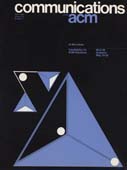April 1980 - Vol. 23 No. 4

Features
Software: recommendations for an export control policy
The control of computer technology exports, for both hardware and software, is being actively debated in government and industry circles. At the request of the U.S. Department of Defense, the Computer Network Critical Technology Expert Group (CNCTEG) was established with the support of the Electronics Industries Association and the Computer Business Equipment Manufacturers Association. The task of the CNCTEG was to assess critical technologies associated with computer networks, and to make recommendations regarding the control of the export of such technologies. The formulation of a reasonable export control policy for software has remained a particularly difficult matter that has frustrated both the U.S. government and industry. This article presents the CNCTEG's initial recommendations for the export control of software.
This material is presented in the belief that open, active discussion among members of the information processing community will be helpful in advancing the development of a sound national policy regarding the export of software products and know-how.
Studying programmer behavior experimentally: the problems of proper methodology
The application of behavioral or psychological techniques to the evaluation of programming languages and techniques is an approach which has found increased applicability over the past decade. In order to use this approach successfully, investigators must pay close attention to methodological issues, both in order to insure the generalizability of their findings and to defend the quality of their work to researchers in other fields. Three major areas of methodological concern, the selection of subjects, materials, and measures, are reviewed. The first two of these areas continue to present major difficulties for this type of research.
Multidimensional divide-and-conquer
Most results in the field of algorithm design are single algorithms that solve single problems. In this paper we discuss multidimensional divide-and-conquer, an algorithmic paradigm that can be instantiated in many different ways to yield a number of algorithms and data structures for multidimensional problems. We use this paradigm to give best-known solutions to such problems as the ECDF, maxima, range searching, closest pair, and all nearest neighbor problems. The contributions of the paper are on two levels. On the first level are the particular algorithms and data structures given by applying the paradigm. On the second level is the more novel contribution of this paper: a detailed study of an algorithmic paradigm that is specific enough to be described precisely yet general enough to solve a wide variety of problems.
A unifying look at data structures
Examples of fruitful interaction between geometrical combinatorics and the design and analysis of algorithms are presented. A demonstration is given of the way in which a simple geometrical construction yields new and efficient algorithms for various searching and list manipulation problems.



